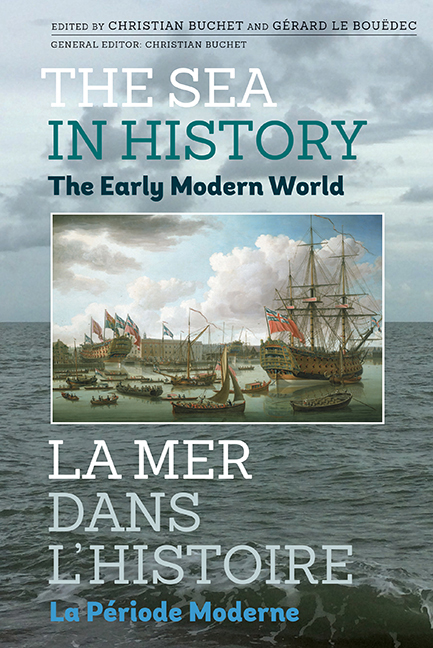Book contents
- Frontmatter
- Contents
- List of Illustrations
- List of Contributors
- Introduction générale et remerciements par
- General introduction and acknowledgements
- Introduction (français)
- Introduction (English)
- LA RÉUSSITE PAR LA MER:La reussite par la mer des territoires et des communautés littorales
- La construction d'un espace mondial: La circulation maritime et les ports
- La forte croissance de l'économie des pêches et des échanges
- Pêches méditerranéennes et développement de l'économie maritime
- The development of fishing fleets in the North Atlantic Ocean
- Les pêches morutières, terre-neuvières, baleinières en Amérique du Nord
- Salt trade in Europe and the development of salt fleets
- Les flottes du vin en Europe: transporter et négocier une marchandise à risque, XVIe-XVIIIe siècles
- L'affirmation de l'Europe baltique et scandinave au XVIIIe siècle
- Sugar and the slave trade in the development of Atlantic maritime trade
- Les flottes négrières de la traite atlantique
- Production and export of tobacco: the development of Atlantic maritime commerce
- Asia–Europe trade: the demand for Asian goods and long-distance shipping from the Indian Ocean and South China Sea
- Les acteurs de la dynamique maritime
- LA PUISSANCE MARITIME INSTRUMENT DE LA PUISSANCE POLITIQUE ET D'UNE STRATÉGIE GLOBALE DE RAYONNEMENT VOIRE DE DOMINATION: Les puissances maritimes occidentales
- L'océan Indien, entre convoitises et indifférences
- Les puissances maritimes asiatiques
- L'Afrique
- La politique maritime et l'idéologie
- Mer et développement technologique
- Développement maritime et maîtrise économique et financière
- Développement maritime et maîtrise organisationnelle
- Conclusion (français)
- Conclusion (English)
- Conclusion générale par
- General conclusion by
- Miscellaneous Endmatter
- Miscellaneous Endmatter
Salt trade in Europe and the development of salt fleets
from La forte croissance de l'économie des pêches et des échanges
Published online by Cambridge University Press: 11 May 2017
- Frontmatter
- Contents
- List of Illustrations
- List of Contributors
- Introduction générale et remerciements par
- General introduction and acknowledgements
- Introduction (français)
- Introduction (English)
- LA RÉUSSITE PAR LA MER:La reussite par la mer des territoires et des communautés littorales
- La construction d'un espace mondial: La circulation maritime et les ports
- La forte croissance de l'économie des pêches et des échanges
- Pêches méditerranéennes et développement de l'économie maritime
- The development of fishing fleets in the North Atlantic Ocean
- Les pêches morutières, terre-neuvières, baleinières en Amérique du Nord
- Salt trade in Europe and the development of salt fleets
- Les flottes du vin en Europe: transporter et négocier une marchandise à risque, XVIe-XVIIIe siècles
- L'affirmation de l'Europe baltique et scandinave au XVIIIe siècle
- Sugar and the slave trade in the development of Atlantic maritime trade
- Les flottes négrières de la traite atlantique
- Production and export of tobacco: the development of Atlantic maritime commerce
- Asia–Europe trade: the demand for Asian goods and long-distance shipping from the Indian Ocean and South China Sea
- Les acteurs de la dynamique maritime
- LA PUISSANCE MARITIME INSTRUMENT DE LA PUISSANCE POLITIQUE ET D'UNE STRATÉGIE GLOBALE DE RAYONNEMENT VOIRE DE DOMINATION: Les puissances maritimes occidentales
- L'océan Indien, entre convoitises et indifférences
- Les puissances maritimes asiatiques
- L'Afrique
- La politique maritime et l'idéologie
- Mer et développement technologique
- Développement maritime et maîtrise économique et financière
- Développement maritime et maîtrise organisationnelle
- Conclusion (français)
- Conclusion (English)
- Conclusion générale par
- General conclusion by
- Miscellaneous Endmatter
- Miscellaneous Endmatter
Summary
ABSTRACT. The salt routes contributed to structuring the commercial routes between northern Europe and Atlantic and Mediterranean Europe. Salt was a vital product for the halieutic industry and agriculture, and was essential for the balance of trade between the north and south of Europe. It was a heavy product that contributed to lowering the price of transportation for long journeys, and often served as ballast in inter-regional trips. Salt or ‘white gold’ was a strategic product for the relations between major producing countries – France and Portugal, the Hanseatic League, Holland and England – that took charge of the traffic, but the large consumers represented by the Baltic and Scandinavian countries would soon be increasingly visible on these salt routes.
RÉSUMÉ. Les routes du sel ont contribué à structurer les circuits du commerce entre l'Europe du nord et l'Europe atlantique et méditerranéenne. Le sel est un produit vital pour l'industrie halieutique et l'agriculture, et essentiel dans l'équilibre des échanges entre le nord et le sud de l'Europe. C'est un produit pondéreux qui contribue à faire baisser le prix du transport au long cours et sert souvent de lest dans les liaisons interrégionales. « L'or blanc salé » est un produit stratégique pour les relations entre les pays producteurs majeurs – La France et le Portugal, la Ligue Hanséatique, la Hollande et l'Angleterre – qui vont s'approprier les trafics, mais les gros consommateurs que sont les pays de la Baltique et de Scandinavie vont progressivement s'imposer sur les routes du sel.
INTRODUCTION: THE SALT TRADE CONSTRAINTS
Approaches to salt trade history must take into account factors which influence their nature and directions, such as the environmental and adaptive ways, and conditions of salt exploitation and production (solar salt, brine and rock salt), the competition between production centres and their adaptation to consumption preferences, the local, regional and world trade circuits, and the political intervention.
Taking the period of 1500–1800 as a whole, how and why did the salt trade fail to achieve a position in the European and Atlantic trade, or even what kind of international rivalry led to shifts in volume and competitive position of producing and consuming countries?
- Type
- Chapter
- Information
- The Sea in History - The Early Modern World , pp. 244 - 253Publisher: Boydell & BrewerPrint publication year: 2017



